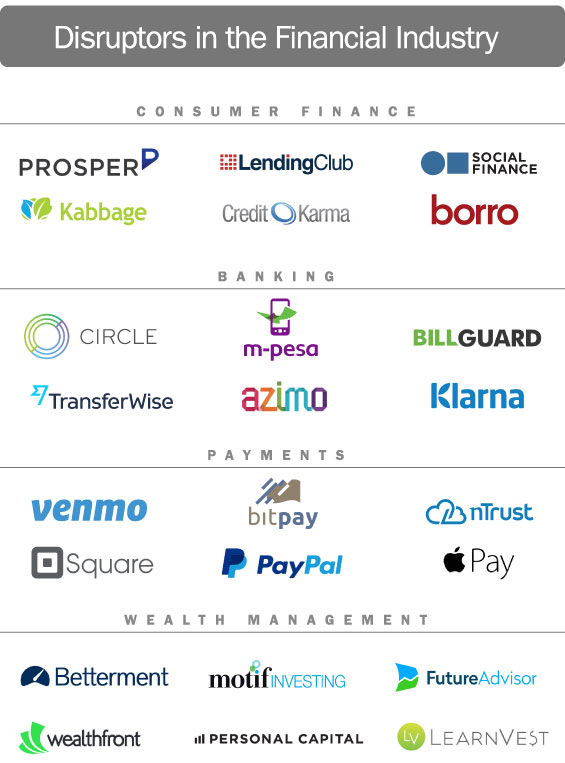A report from SAP and Bain & Company warns that financial industry outsiders are challenging the status quo, putting 32% of banking revenues at risk by 2020. These disrupters are actively pushing into every part of the financial services sector. They’re basically telling traditional institutions, “Hey, I can innovate faster than you can evolve.”
And while these disruptive companies are outsiders, they are not small. LendingClub has nearly $6 billion dollars in active loans. Social Finance, which refinances education loans, received a billion dollars of private equity money. These companies aren’t run by bankers or insurance executives — these are former employees of companies like Google and Twitter, with a lot of money behind them. They understand that consumers want a different experience and different product features, and they understand where those two things intersect.
Read More: iPhone X: The Next Wave of Mobile Banking Disruption

Are You Ready for a Digital Transformation?
Unlock the potential of your financial institution's digital future with Arriba Advisors. Chart a course for growth, value and superior customer experiences.

Unlocking Digital Acquisition: A Bank’s Journey to Become Digital-First
This webinar will offer a comprehensive roadmap for digital marketing success, from building foundational capabilities and structures and forging strategic partnerships, to assembling the right team.
Read More about Unlocking Digital Acquisition: A Bank’s Journey to Become Digital-First
Banking
Consumers of all ages are shifting how they research, shop for and buy products, which, in turn, changes how financial institutions market to them. But Millennials, the largest demographic segment out there, behave differently than previous generations. This is having a rapid and profound effect on the banking industry, creating ripe opportunities for disrupters to come in and challenge the status quo.
As acquisition channels evolve, it’s difficult to understand consumers’ needs and align your products accordingly. Historically, consumers sat across from a banker. Now, as the branch channel wanes and banking becomes less about one-to-one personal engagement, banks and credit unions need to figure out how to deliver a consultative selling experience in alternate channels.
Credit Cards
Let’s roll back to 2008. How did you compete for credit cards? From an acquisition perspective, direct mail was king. Today, direct mail is still the workhorse it once was, but will it still reign supreme five years from now? Probably not. Many of those in Generation X got their first credit card standing in a line at a registration desk at college. But credit card companies were kicked off university campuses, and Millennials aren’t acquiring credit cards the way previous generations did. What next?
The mobile wallet is impacting the visibility and rotation of consumers’ payment options. Historically, consumers have pulled out their wallets to see all their cards neatly staged — “Which one do I want to use?” Well, the mobile wallet can disintermediate traditional card issuers. When all someone needs to do to make a payment is swipe their finger or wave their phone in the air, are they going to engage and think about their card in the same way they once did? No, then won’t. Money and how payments are made will become even more abstract than it already is today. Consumers won’t think about the product’s benefits? That’s changing, and it’s changing the way that we market.
Consumer Lending
The consumer finance sector is seeing more fintech disruption than anywhere else. People are buying houses again and they are more comfortable assuming debt, but at the same time, the way consumers want are buying homes has changed dramatically (think: Zillow, rate comparison sites, etc.). Traditional banking providers have been slow to respond. There are new competitors banging on consumers’ digital doorsteps saying, “Hey, I may not be a bank, but I’ve got a lot of money to lend.” This makes competition in the consumer lending market much tougher.
Wealth Management
Wealth management brands are trying to replace the old model where someone sat in between that consumer and the wealth management company, and are instead building direct connections with individual consumers. If they can capture just one tiny fraction of the money that moves from a 401(k) program and reinvest it, it would make a meaningful impact for most wealth firms. Traditional players in the wealth space are running as fast as they can to build out their online capabilities. Conversely, the digital disruptors are saying, “Yikes, people still like to work with agents, so we need to build up our one-to-one advice capabilities.” And that’s changing the way that wealth management brands are marketing as well.
Insurance
How much does the insurance industry spend on advertising? Gobs and gobs! You can’t turn on the television without seeing the GEICO gecko, Progressive’s redhead comedian Flo, ads from Allstate, or Liberty Mutual, or State Farm. It’s one of the largest areas of media spend, and it’s still growing. It’s very difficult for insurance companies to get and maintain a competitive share of voice in traditional media channels, so they are investing more in digital targeting capabilities.
The “Internet of Things” is also radically transforming the insurance industry. For instance, insurers like Travelers and Progressive are using USB ports consumers’ cars to determine how often and riskily they drive, directly impacting their premiums. This example demonstrates how the experience and competition is evolving in the insurance industry.
Regardless of the side you represent, today’s digital world creates new challenges and opportunities for traditional and disruptive financial models alike. Traditional models must evolve to both protect their existing market share and grow, while disruptive models must continue to innovate faster than everyone else. However, one thing remains true for both — today’s digitally empowered customer must be the focus of every business strategy.








